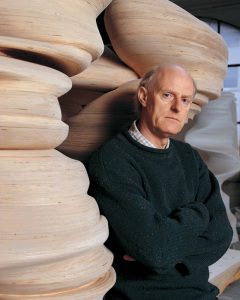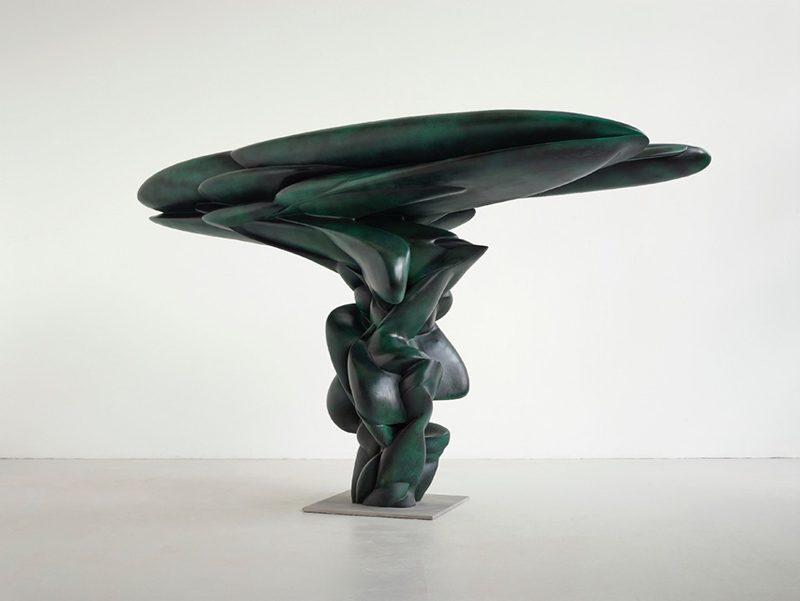TRACES: Tony Cragg
 Today is the occasion to bear in mind Tony Cragg (9/4/1949- ), using a vast array of materials, Tony Cragg in the ‘80s opened up new possibilities in the field of sculpture. His works are eclectic and playful, bringing together discarded objects in surprising ways. Through documents or interviews, starting with: moments and memories, we reveal out from the past-unknown sides of big personalities, who left their indelible traces in time and history…
Today is the occasion to bear in mind Tony Cragg (9/4/1949- ), using a vast array of materials, Tony Cragg in the ‘80s opened up new possibilities in the field of sculpture. His works are eclectic and playful, bringing together discarded objects in surprising ways. Through documents or interviews, starting with: moments and memories, we reveal out from the past-unknown sides of big personalities, who left their indelible traces in time and history…
By Efi Michalarou
 Tony Cragg was born in 1949 in Liverpool,following a period of work as a laboratory technician he first studied art in the Foundation course at the Gloucestershire College of Art and Design, Cheltenham and then at the Wimbledon School of Art (1969-1973). During this period he was taught by Roger Ackling, who introduced him to the sculptors Richard Long and Bill Woodrow. He completed his studies at Royal College of Art (1973-1977) where he was a contemporary of Richard Wentworth. Tony Cragg’s early work involved site-specific installations of found objects and discarded materials. From the mid–’70s through to the early-‘80s he presented assemblages in primary structures or as in colourful, representational reliefs on the floors and walls of gallery spaces. “Britain Seen from the North” is a signature early work, made of multi-colored scraps of various materials assembled in relief on the wall. He left Britain in 1977 and moved to Wuppertal in Germany, where he has lived and worked since, in 1978 began teaching at the Kunstakademie of Düsseldorf. In the early ‘80s Cragg gradually moved away from installation art and began to examine more closely the individual objects used as parts of his larger constellations. This was the beginning of his engagement and experimentation with the properties and possibilities of a wide range of more permanent materials in the form of wood, plaster, stone, fiberglass, Kevlar, stainless steel, cast iron and bronze. Throughout the ‘90s Cragg continued to develop two larger groups of work that have sustained his production up to the present: the “Early Forms” and the “Rational Beings”. The “Early Forms” series investigate the possibilities of manipulating everyday, familiar containers and the ways in which they can morph into and around one another in space. The “Rational Beings” are describable as organic looking forms often made of carbon fibre on a core of polystyrene. These sculptures derive their forms from the contours of gestural drawings, which Cragg then translates into the third dimension using thick, circular or oval discs which are superimposed, glued together and covered with a skin. The underlying structure of these sculptures gives their skin the tension of a membrane, reflecting the basic structures of many organisms, organs, plants and animals. Much of Cragg’s recent work has experimented with the manipulation of the human face, the use of stacking and layering and the effects of centring his architectural pieces, such as “Here Today, Gone Tomorrow”, around variable axes. This work is, characteristically, animated and infused with a sense of movement and pace, a fleetingness stressed by the work’s title. Whilst the piece appears to be spinning at speed, it also seems to have been subject to wind and water erosion as a result of its smooth, undulating and topographical form.
Tony Cragg was born in 1949 in Liverpool,following a period of work as a laboratory technician he first studied art in the Foundation course at the Gloucestershire College of Art and Design, Cheltenham and then at the Wimbledon School of Art (1969-1973). During this period he was taught by Roger Ackling, who introduced him to the sculptors Richard Long and Bill Woodrow. He completed his studies at Royal College of Art (1973-1977) where he was a contemporary of Richard Wentworth. Tony Cragg’s early work involved site-specific installations of found objects and discarded materials. From the mid–’70s through to the early-‘80s he presented assemblages in primary structures or as in colourful, representational reliefs on the floors and walls of gallery spaces. “Britain Seen from the North” is a signature early work, made of multi-colored scraps of various materials assembled in relief on the wall. He left Britain in 1977 and moved to Wuppertal in Germany, where he has lived and worked since, in 1978 began teaching at the Kunstakademie of Düsseldorf. In the early ‘80s Cragg gradually moved away from installation art and began to examine more closely the individual objects used as parts of his larger constellations. This was the beginning of his engagement and experimentation with the properties and possibilities of a wide range of more permanent materials in the form of wood, plaster, stone, fiberglass, Kevlar, stainless steel, cast iron and bronze. Throughout the ‘90s Cragg continued to develop two larger groups of work that have sustained his production up to the present: the “Early Forms” and the “Rational Beings”. The “Early Forms” series investigate the possibilities of manipulating everyday, familiar containers and the ways in which they can morph into and around one another in space. The “Rational Beings” are describable as organic looking forms often made of carbon fibre on a core of polystyrene. These sculptures derive their forms from the contours of gestural drawings, which Cragg then translates into the third dimension using thick, circular or oval discs which are superimposed, glued together and covered with a skin. The underlying structure of these sculptures gives their skin the tension of a membrane, reflecting the basic structures of many organisms, organs, plants and animals. Much of Cragg’s recent work has experimented with the manipulation of the human face, the use of stacking and layering and the effects of centring his architectural pieces, such as “Here Today, Gone Tomorrow”, around variable axes. This work is, characteristically, animated and infused with a sense of movement and pace, a fleetingness stressed by the work’s title. Whilst the piece appears to be spinning at speed, it also seems to have been subject to wind and water erosion as a result of its smooth, undulating and topographical form.














